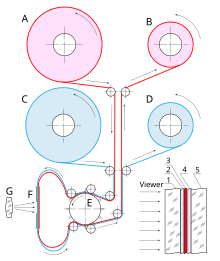This article needs additional citations for verification. (July 2007) |

- A - back film feeding reel
- B - back film take-up reel
- C - front film feeding reel
- D - front film take-up reel
- E - sprocket
- F - film gate
- G - lens
- 1 - front film base
- 2 - front film orthochromatic emulsion
- 3 - front film red filter layer
- 4 - back film panchromatic emulsion
- 5 - back film base
In cinematography, bipacking, or a bipack, is the process of loading two reels of film into a camera, so that they both pass through the camera gate together. It was used both for in-camera effects (effects that are nowadays mainly achieved via optical printing) and as an early subtractive colour process.[1]
- ^ Read, Paul; Meyer, Mark-Paul (2000). Restoration of Motion Picture Film. Oxford: Elsevier Science. pp. 43, 310. ISBN 075062793X. OCLC 45352344.